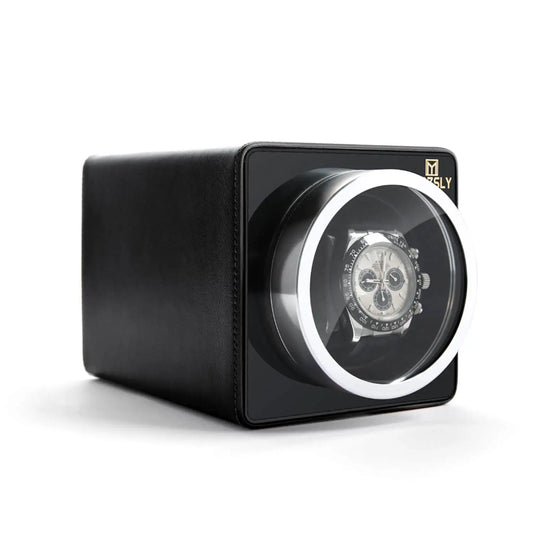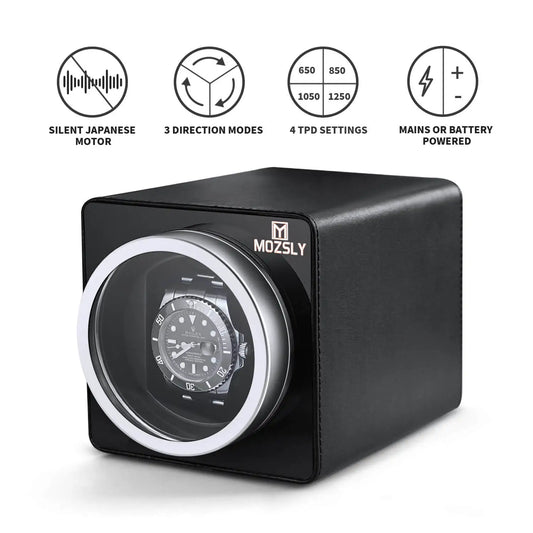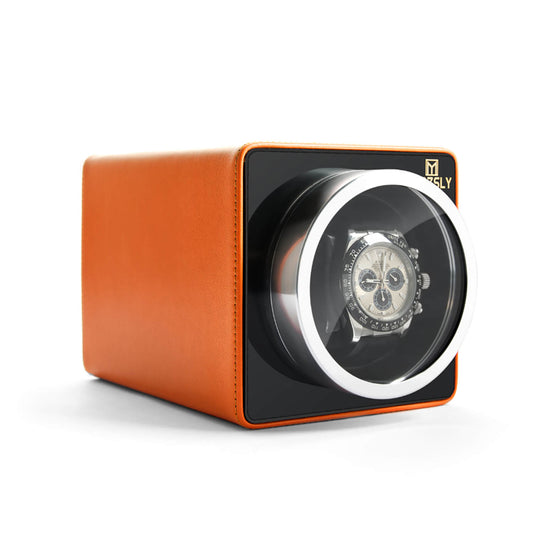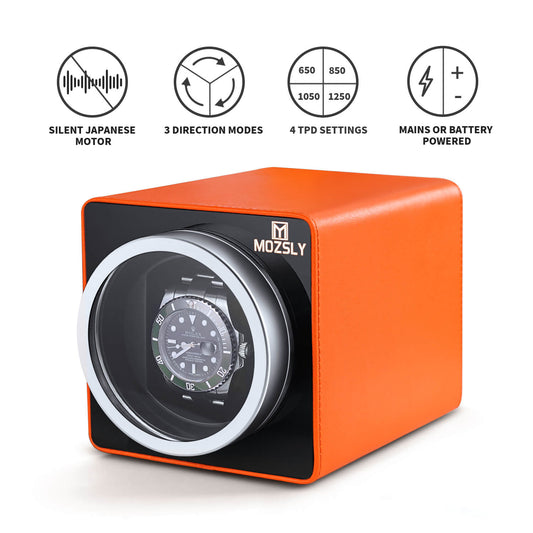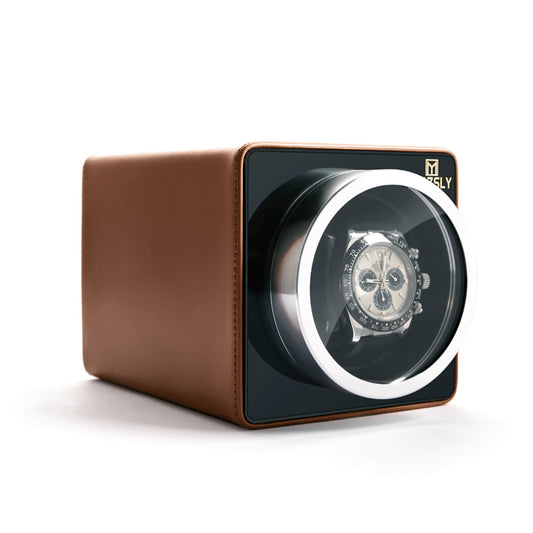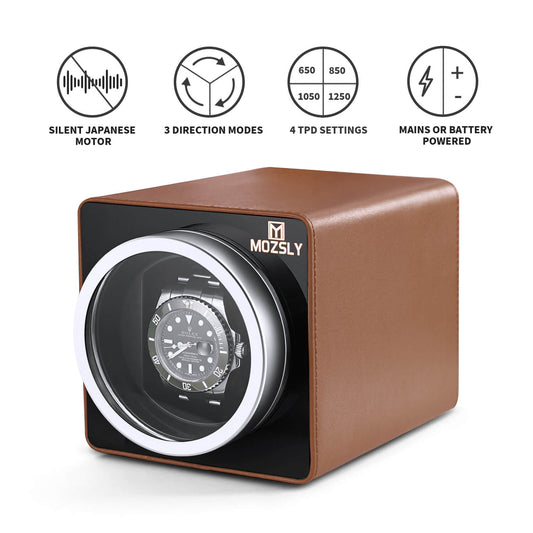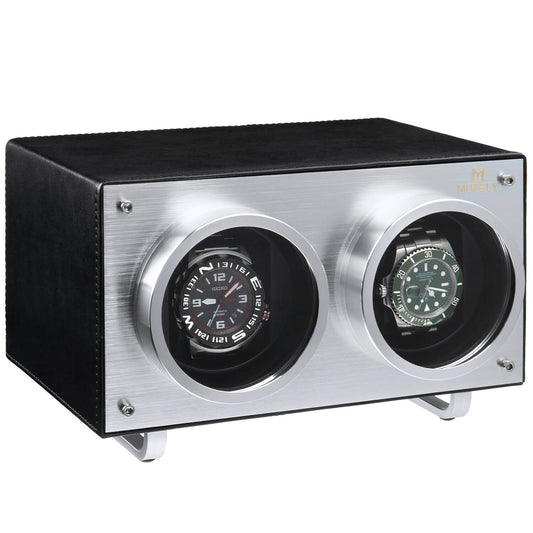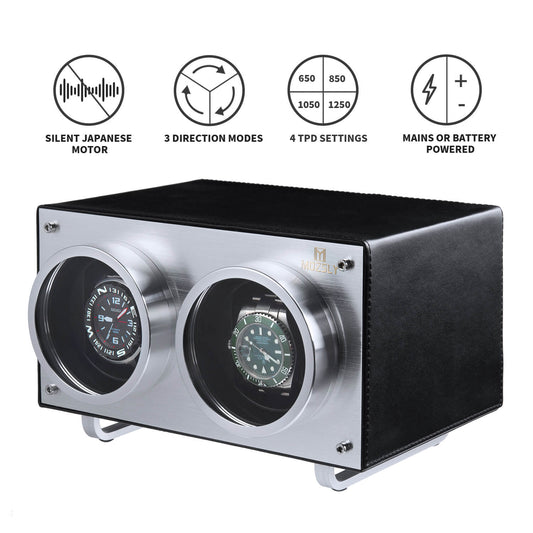Watch Winder VS Manual Winding, Which One Do You Choose?
Watch Winder VS Manual Winding, Which One Do You Choose?
Watches are one of the most popular accessories, and owning multiple watches is a growing trend. However, when the number of watches in one's collection increases, it becomes difficult to wind all of them. This is especially true for watches with complications, such as perpetual calendars.
I will compare and contrast the two main methods of winding a watch: watch winders and hand winding. Today we will discuss the difference between a watch winder and a hand winder. We'll also give you an in-depth look at how to use a watch winder and see how it works so you understand the differences. Often hesitant to choose between a watch winder or manual winding. So what's the difference between the two? Which one is right for you?
Watch Winder VS Manual Winding - Which To Choose?
- Manual winding by turning the crown
- Use a watch winder.
The Benefits of Keeping Your Automatic Watch
RunningConvenience - take it out and use the it-The whole idea of keeping our automatic watches running is about convenience. This means we just take the watch out of the drawer and put it on.
No need to adjust the time or day/date-No need to adjust the time and day/date whenever we want to use it. This saves time and is perfect for those in a Monday morning rush. This is great for watches with complications like moon phases and perpetual calendars that are designed to run all the time for the complications to work flawlessly.
will keep the internal mechanism running-Another advantage of keeping it running is that the internal mechanism will always run, preventing the lubricating oil from freezing or congealing, ensuring that the watch keeps accurate time.
Make sure the lubricating oil does not freeze or condense-But this only applies to old and inferior watches that use mineral oil. If the mechanism is left untouched for a long time, these oils can congeal, making your watch inaccurate or even impossible to start. But now the new watches are generally made of synthetic oil, so this problem does not exist.
Watch Winder VS Manual Winding
Advantages of watch winders
- There must be a reason why people still use them, and if you have a collection of several watches, you will want to wear them all. However, you can't do both at the same time. So when you decide to change, a watch winder keeps all your unworn watches ready to wear. Especially for watches with complications like perpetual calendars, resetting them can be time-consuming.
- A watch winder is primarily a storage device. A key feature of a good winder is its ability to protect the inside of the watch from moisture. Moisture is ultimately the watch's nemesis. Since it has many small moving parts, mostly metal, water becomes a wreck for the watch through corrosion. Keeping your watch in a padded and secure interior will protect it from moisture as well as nicks and scratches from the outside world.
- Flaunt your display. Watch barrels are designed to provide you with a sleek and contemporary space that complements your traditional and contemporary styles. Secure each hand, and watch in a dedicated compartment where they are well displayed - waiting to be worn and enjoyed by their owners.
Advantages of manual winding
- The whole idea of keeping our automatic watches running is convenient, meaning we just take the watch out of the drawer and put it on.
- For those fascinated by the micro-mechanics in a mechanical watch, a hand-wound watch with a see-through case back is a huge plus, as it lets you see more of the movement.
- Without a weighted oscillating weight in hand-wound watches, watchmakers can make mechanical movements significantly thinner and lighter on the wrist.
Disadvantages of watch winders
- Price tag. A watch winder, especially a good quality watch winder, can cost thousands of dollars. Many would argue that a fraction of that cost should be invested in a good storage device compared to the price of the watch itself. While that's a valid point, many watch lovers can't even afford their dream watch, let alone a storage box that takes a chunk of their paycheck.
- Magnetic. A bigger problem when using a watch winder is dealing with the magnetic force from the motor. Remember, motors use a magnetic field to spin. Spinning a watch in the magnetic field created by a poorly shielded motor can cause problems, especially with the sensitive hairspring in the watch movement. If you decide to use a watch winder, it is important to take this into consideration, choosing quality above all else.
Disadvantages of manual winding
- The rotor is weighted and since it is a weighted rotor, your watch will be heavier and thicker. To some, this may be a scam to others, and while it's not, it's still worth mentioning.
- Those who aren't interested in the inner workings of manual watches and just wear them to tell the time may sometimes find the daily crown-winding ritual a bit tedious. Constantly turning the crown to wind the mainspring will cause the crown's seals to wear prematurely (compared to automatic watches that are primarily wound by the rotor). For those who like to watch the gears turn through the transparent case back, the rotor can be a bit of a hindrance as it hides part of the movement.
1) Using a watch winder
A watch winder is a great option for anyone who doesn't want to manually wind their watch every day. It is easy to use and can also be used as a box to hold your clock and can be a very nice addition to your bedroom.
Another great use for a cord winder is when you're going on vacation or on a business trip. In these cases, you cannot carry your entire watch collection with you, and it is impossible to manually wind the watch every day. A watch winder is a perfect tool for these situations.
A winder cannot overwind an automatic watch, as all automatic watches prevent overwinding by a mechanism that disengages from the winding process when the mainspring is fully wound. But using a timer-based winder is still very important to prevent excessive wear on the winding mechanism. A watch doesn't need to run 24 hours a day, it usually only needs 30 minutes to be properly wound.
A winder is completely useless for a battery-powered quartz watch. But they do apply to special "battery-free" quartz watches, these automatic/quartz hybrids use the same weight/rotor principle to generate electricity to run a quartz movement.

Winding by watch winder
2) Rotating crown manual winding
How to manually wind your automatic watch?
The position of the crown, turns the crown clockwise, and there will be a magnetic sound, and the feeling of resistance means winding up, usually, about 25-30 turns are considered to be fully wound. Wind the mainspring after adjusting the time.
During the winding process, do not use excessive force. Doing so will damage the crown as it is the weakest part of the watch. Excessive force may damage the gears inside,
Most modern watches have an automatic sliding system when fully wound (the crown slides in an infinite loop), so you don't have to worry about damaging the movement with too much winding. So there is no need to worry about overwinding the watch.

Manual winding by turning the crown
Comparison of the characteristics of watch winding device and manual winding
- Hand-wound watches allow people to be more involved.
Many hand-wound watches have a transparent case back, which is a unique design that allows a direct view of the inner movement. Especially when you turn the crown, you will hear the sound of the gears turning after the mainspring has accumulated energy. The ticking makes you have more interaction with the watch, and you feel more engaged. This is why many watch collectors like manual-winding watches. Winding your watch every day is like a novel way to relax. This provides a sense of connection between you and your watch. You will find joy in watching the movement run due to your movement of turning the crown.
- The watch winder provides safe storage.
A watch winder will not only keep your watch professionally wound, but placing your watch on cushions and safe spaces within your timepiece will help protect it from moisture, nicks, and exterior scratches. Protecting your watch from damage, the watch winder also helps prevent unwanted watch loss.
What types of watch winders are there?
Functionality: various functions of the watch winder. In which direction does the rotor wind up the mainspring? It can be clockwise, counterclockwise, or even what we call bi-directional. Then there's "revolutions per day," which is essentially knowing how many revolutions the rotor makes to fully wind your watch.
Elegant: These cord winders go beyond pure function and offer a beautiful form and look. Usually, they are fully enclosed boxes, usually made of finished wood or covered with leather. They are suitable for display on a desk or dresser, but many can fit inside a drawer or safe.
Luxury: As with many luxury items, the sky is the limit of options. Winders with heaters to keep the watch close to body temperature, built-in storage drawers, and atomic synchronized time displays are some of the esoteric and transcendent features offered by some very high-end winders.
How does a watch winder work?
-
When the watch owner is not going to wear the watch that day, they will carefully place the watch in the watch winder.
-
Once secured in the watch winder, follow the winder manufacturer's instructions to make the appropriate adjustments to the winder's controls. These may include direction of rotation, revolutions per day (TPD), duration of operation, etc. See your watch manual for details on winding direction and TPD. Can't find that information in your manual? Check out this handy guide.
-
The watch winder will then be turned on. Batteries or AC power run watch winders, so they need to be turned on by pressing a button or plugged into a power source.
-
Before pausing, the watch winder will begin to mimic the movements and movements associated with the human wrist. The frequency and length of the pauses will depend on your particular TPD setting, but most watch winders will turn for 30 seconds to a minute before pausing.
-
When owners decide to wear their watch again, they remove the watch from the watch barrel and put it on their wrist.
Will a watch winder damage a watch?
People are worried that the grease in the watch will condense due to idleness. The oils used in most modern watches and well-maintained vintage watches are less prone to condensation or solidification. While there are technical reasons in favor of a watch running continuously, there are also reasons in favor of not overusing it unnecessarily.
There is no clear evidence that a good watch winder will save or break your watch. A watch winder is an auxiliary tool for automatic mechanical watches. Its function is to maintain the movement of the movement. Set the number of rotations and direction per day according to the characteristics of the movement, so as not to cause damage to the watch due to excessive winding. On the contrary, if the watch is left and stopped for a long time, it may cause the lubricating oil of the movement to condense, which is more likely to cause wear on the movement parts, and the frequent time adjustment caused by the stop and go will also increase the chance of movement damage.
A Few Things to Consider When Buying a Watch Winder
Prices for watch winders range from $50 to hundreds of dollars. Then buying the correct watch winder is important for you. Here are some tips for choosing the right watch winder for your timepiece.
a) Motor quality
The motor is an important part of the winding machine. While other build quality factors will often show their flaws over time, one of the first things that can cause frustration is the noise a watch winder makes. Many cheap-watch winders will have noisy motors with minimal sound attenuation, which can be irritating. Investing in a high-quality motor is a moral decision.
b) Fashion design
You want your watch barrel to display your watch collection beautifully. Choose a simple bedside wrap to match your bedroom aesthetic, or a larger vault-style wrap to showcase your impressive collection. A gorgeous cord winder to showcase your impressive collection can make a great addition to your home decor.
c) In which direction does it spin?
Some watches wind up clockwise or counterclockwise. More expensive winders will have two options. This is very important because not all automatic watches have rotors that spin in both directions.
Some watches only turn in one direction. Again, you need to confirm with your watchmaker how the movement rotates.
For example, a movement with an oscillating weight that only rotates clockwise requires a counterclockwise winding winder to properly wind the watch.
If cannot reach your watch manufacturer, you can try to use the MOZSLY database for inquiries. MOZSLY , a manufacturer of watch winders, maintains a comprehensive database of the direction of rotation of many watches. You can check it out here.
d) How many revolutions per day (TPD)?
Different watches have different revolutions per day (TPD) requirements, ranging from 650 to 1800 revolutions per day for most automatic watches. For example, a Rolex requires 650 TPD bi-directional, while a Patek Philippe requires 900 TPD clockwise and anti-clockwise. If your collection is a fair mix of various makes and models, it depends on how you prefer to use the cord winder.
As always, please contact your watch manufacturer for details on your watch’s TPD specification. Alternatively, you can also check the TPD settings in the MOZSLY database (MOZSLY TPD database ).
e) Battery or AC adapter?
Most watch winders have a power adapter and must always be plugged in, requiring them to be near a power outlet. Battery-powered watch winders are also available, but most usually require frequent battery changes, and most users find themselves unaware of this until they discover their watch is dead.
So, do you need a watch winder?
So the big question is: do you need a watch winder? It really depends on a lot of factors.
One, watching winders can be expensive and they may turn some people off.
Not to mention that manual winding is perfectly fine and serves the same purpose of keeping the watch running.
But for those who have a large collection of watches, it is a hassle to wind these watches every day.
In the end, you have to decide for yourself whether you need one.
Where can I buy a watch winder?
For those who decide to buy a watch winder, you can check out the deal on Amazon. Amazon has a huge selection of watch winders.
Here I list 2 highly rated MOZSLY some of the most popular cable winders:
MOZSLY® Double Watch Winder -Orange Leather

- Material: wooden box/PU leather/acrylic board
- Color: Orange/Black/Brown/Carbon Fiber
- Size: 8.8*5.9*4.7 inches
- 4 modes with TPD settings ranging from 650 to 1500
- All three winding directions are supported
- Antimagnetization
- Use Japanese upgraded Mabuchi motor
- Dual power
- 3 Years Warranty
- This watch features a unique orange winding with a multi-layer paint process for a more beautiful, shiny, and smooth finish. Inside, the leather and wood grain look sleek and luxurious. looks great.
MOZSLY® Single Watch Winder - Black Leather
- Material: wooden box/PU leather/acrylic board
- Colour: Black
- Dimensions: 4.4 x 6 x 4.4 inches
- 4 modes with TPD settings ranging from 650 to 1500
- All three winding directions are supported
- Antimagnetization
- Use Japanese upgraded Mabuchi motor
- Dual power
- 3 years warranty
MOZSLY watch winders use high-quality upgraded Japanese Mabuchi motors, a well-known brand that manufactures precision motors. These motors keep the noise below 10 decibels, so even if you put it in your bedroom, it will give you a very quiet experience.
The internal motor is closed and can be separated from the watch so that the watch will not be magnetized and affect the travel time. With a 36-month warranty and friendly customer service, we welcome you to purchase our watch winders.
Some Suggestions
Today, with the rapid development of science and technology, people's demand for products is intelligence and convenience. The watch winder is easy to use and is the choice of many people. By the way, if you have more than one automatic watch, you can buy a watch winder to help you wind your watch when you are not wearing it.
Young people like sports, so manual winding may be a good choice. The elderly do not have so much exercise time, so I recommend using a watch winder.



